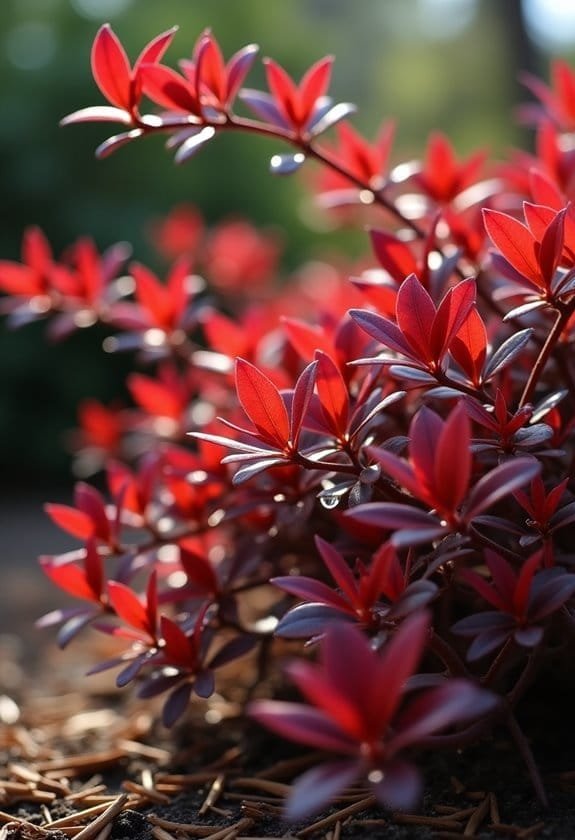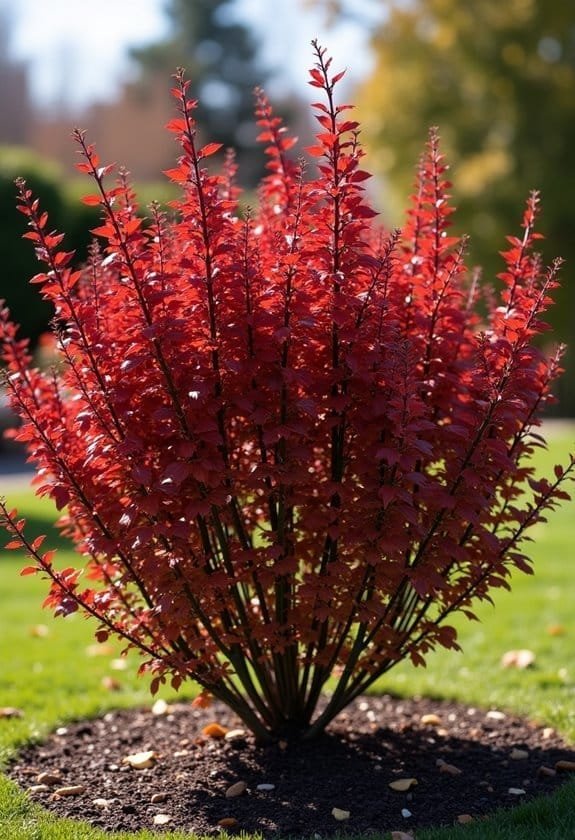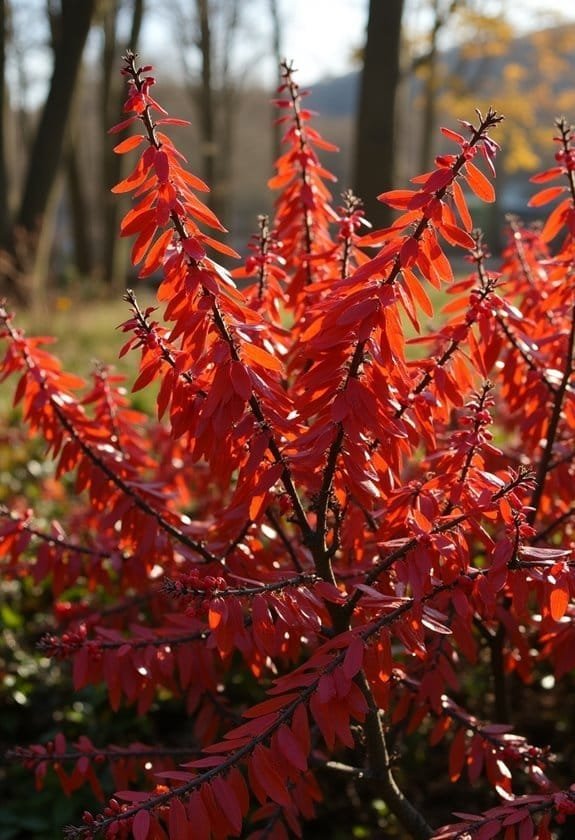Japanese barberry (Berberis thunbergii) is a spiny deciduous shrub that's become both prized and problematic since its 1860s introduction to North America. The plant grows 3-7 feet tall, featuring distinctive reddish-purple foliage and crimson berries that catch the eye in ornamental gardens. While it's adaptable to various conditions in USDA zones 4-8, its aggressive growth habits form dense thickets that outcompete native species and create favorable conditions for tick populations. This controversial plant's ability to thrive in diverse environments, coupled with its invasive tendencies, makes understanding its management essential for responsible cultivation.
Main Points
- Japanese barberry is an ornamental shrub introduced to the U.S. in the 1860s, known for crimson berries and spiny stems.
- It grows 3-7 feet tall, forms dense thickets, and thrives in USDA hardiness zones 4-8 with various soil conditions.
- The plant features reddish-purple foliage, glossy red berries, and simple alternate leaves, making it popular in landscaping.
- It's classified as invasive in many states, outcompeting native plants and creating favorable conditions for tick populations.
- Management requires both physical removal and chemical control methods, with early intervention crucial before July seed production.
Introduction

Japanese barberry (Berberis thunbergii), a deciduous shrub first brought to American shores in the 1860s, represents one of the most widespread ornamental plants that has naturalized across North America.
Known for its crimson berries and spiny stems, this member of the Berberidaceae family demonstrates remarkable adaptability in various environmental conditions, from shaded woodlands to open fields.
This hardy species has transformed from a popular garden choice into an aggressive invader, forming dense thickets that can reach heights of 3 to 7 feet and considerably alter native ecosystem dynamics.
Common Name
Known throughout gardens and landscapes worldwide, Berberis thunbergii goes by the common name Japanese barberry, reflecting its native origins in Japan and eastern Asia. This ornamental shrub has become a familiar sight in residential and commercial landscapes, where its distinctive characteristics have made it a popular choice among gardeners and landscapers alike.
The name "Japanese barberry" effectively captures both the plant's geographical origins and its botanical classification within the barberry family. While its scientific designation, Berberis thunbergii, honors Swedish naturalist Carl Peter Thunberg, the common name serves as a more accessible identifier for general use.
Despite its ornamental appeal, the plant's status as an invasive species has led to increasing awareness about its potential impact on native plant communities. In many regions, Japanese barberry has established itself beyond cultivated spaces, earning additional colloquial names such as "red barberry" or "thunberg's barberry," which reference its distinctive reddish-purple foliage variants.
These various names reflect both the plant's aesthetic appeal and its complex relationship with local ecosystems.
Scientific Name
Botanists and horticulturists recognize Berberis thunbergii as the scientific name for Japanese barberry, first documented by Swiss botanist Augustin Pyramus de Candolle (DC.) in the 19th century. This taxonomic classification places the shrub within the Berberidaceae family, establishing its relationship to other barberry species worldwide.
The species name "thunbergii" reflects the botanical legacy of its classification, while serving as the universal scientific identifier for this invasive ornamental shrub across international borders. As a native species to China and Japan, Berberis thunbergii has adapted remarkably well beyond its original range, particularly after its introduction to the United States during the 1860s.
The plant's scientific designation encompasses all varieties of the species, which can range in height from 3 to 7 feet and display various leaf colorations from bright green to deep purple. These variations, while horticulturally significant, all share the species' characteristic features: simple alternate leaves measuring 1/2 to 1 1/4 inches long and glossy red berries that persist through winter, contributing to the plant's successful spread through avian dispersal.
Overview
The versatility and adaptability of Berberis thunbergii have made it both a popular ornamental choice and a concerning invasive species across North America. This deciduous shrub, commonly known as Japanese barberry, has transformed from a decorative garden addition into a significant ecological challenge since its introduction to the United States in the 1860s.
Growing between 3 to 7+ feet in height, this robust plant demonstrates remarkable resilience through its ability to thrive in diverse soil conditions and light environments. Its dense growth pattern, characterized by spiny stems and vibrant red berries that persist through winter, creates impenetrable thickets that effectively outcompete native plants.
The species has earned its classification as a noxious weed in several states, including Massachusetts and Pennsylvania, due to its aggressive colonization strategies.
What makes Japanese barberry particularly problematic is its dual reproduction capabilities. Through both prolific seed production and vegetative spreading via rhizomes, it rapidly establishes itself in new territories.
This invasive shrub not only alters local ecosystem dynamics but also creates favorable conditions for tick populations, raising additional environmental and health concerns.
Key Features
Japanese barberry stands out as a compact yet commanding shrub, reaching heights of 3 to 7+ feet with its dense, rounded form and numerous branching patterns.
Throughout the growing season, its alternate leaves, measuring 1/2 to 1 1/4 inches, transform from vibrant spring greens to striking autumn colors, creating a dynamic display in the landscape.
The plant's most distinctive features include its spiny stems, which emerge singularly at each node, and its bright red, ellipsoidal fruits that persist through winter, attracting various bird species.
Growth Size
Reaching heights of 3 to 7 feet at maturity, Berberis thunbergii develops into a compact, rounded shrub with an equally impressive spread of 4 to 7 feet. The Japanese barberry's dense growth habit makes it particularly effective as a natural barrier or defining element in landscape design, where its symmetrical proportions create a strong visual presence.
This versatile shrub maintains its compact shape throughout its growth cycle, with its characteristic spiny stems contributing considerably to its dense structure. Each stem features a single spine at each node, creating an intricate network that supports the plant's robust framework.
The shrub's growth pattern accommodates its abundant foliage, which consists of alternate leaves measuring 1/2 to 1 1/4 inches in length, arranged in a manner that maximizes coverage and creates an impenetrable hedge when planted in series.
The plant's moderate size and controlled growth rate make it particularly suitable for both residential and commercial landscapes, where its manageable dimensions allow for easy maintenance while providing substantial coverage for privacy screens and border plantings.
Appearance
Visually striking throughout the seasons, Berberis thunbergii showcases distinctive features that make it instantly recognizable in any landscape. The Japanese barberry's most notable characteristic is its array of spiny stems, with each node displaying a single sharp spine that serves as both protection and identification marker.
The shrub's foliage presents a remarkable display of simple, alternate leaves measuring between 1/2 to 1 1/4 inches in length. These leaves transform from bright green to deep crimson or purple hues as autumn approaches, creating a spectacular seasonal shift.
During late spring, delicate pale yellow flowers, measuring 0.3 to 0.5 inches, emerge discreetly beneath the foliage canopy, adding subtle charm to the plant's appearance.
Perhaps the most eye-catching feature appears after flowering, when bright red, glossy berries develop and persist through winter months. These ellipsoidal fruits stand out dramatically against barren winter landscapes, providing visual interest long after other plants have shed their foliage.
The plant's dense, broad form creates an impressive architectural presence, whether used as a specimen plant or incorporated into mixed borders.
Flowering Season
Throughout spring, Berberis thunbergii displays its distinctive flowering pattern, with delicate pale yellow blooms emerging from April to June. These modest flowers, measuring between 0.3 to 0.5 inches, cluster beneath the shrub's dense foliage, creating a subtle yet notable display that supports the plant's reproductive cycle.
The flowering season of Japanese barberry serves multiple ecological functions, marking the beginning of its annual reproductive phase. As the pale blossoms develop into vibrant red, ellipsoidal berries, they become natural beacons for birds, facilitating seed dispersal throughout the surrounding landscape.
This timing also coincides with the plant's early leaf emergence, providing it with a competitive advantage over native species through enhanced photosynthetic capabilities.
For land managers and gardeners, understanding this flowering period is essential for effective control measures. The change from flowering to berry development, which occurs around July, represents a vital window for management interventions, as removing the plants before seed ripening can greatly reduce their spread and ecological impact in subsequent seasons.
Growing Requirements

Japanese barberry flourishes in environments that offer full sun to partial shade, making it a versatile addition to various landscape settings.
The shrub demonstrates remarkable adaptability to diverse soil conditions, though it reaches peak performance in well-drained, nutrient-rich soil where its extensive root system can establish properly.
While tolerant of USDA zones 4-8, this hardy plant requires consistent moisture during its establishment period and benefits greatly from a protective layer of mulch around its base.
Light
Berberis thunbergii thrives best in full sun conditions, though it can adapt to partial shade environments. This adaptability allows Japanese barberry to establish itself across diverse habitats, from open meadows to shaded woodlands, making it a particularly successful invasive plant.
In ideal sunlight conditions, the shrub develops its most vibrant foliage and maintains robust growth patterns throughout the growing season.
The plant's relationship with light plays an essential role in its competitive advantage over native species. By leafing out earlier in spring, it captures available sunlight before other plants emerge, extending its photosynthetic period and strengthening its foothold in various ecosystems.
While the species demonstrates remarkable adaptability to different light conditions, there are notable effects on its appearance and growth habits. In areas with reduced sunlight, the characteristic bright red varieties may gradually shift to greener hues, though the plant remains viable.
This solar flexibility, combined with its ability to flourish in both bright and partially shaded locations, contributes greatly to its success as an aggressive colonizer in North American landscapes.
Soil
A wide variety of soil conditions support the growth of B. thunbergii, demonstrating its remarkable adaptability as a landscape plant. This versatile shrub flourishes in sandy, loamy, and clay soil types, making it an excellent choice for diverse garden settings and urban landscapes.
While Japanese barberry shows a clear preference for well-drained, fertile, and moist soil conditions, its resilient nature allows it to thrive even in poor soil conditions that might challenge other ornamental plants.
The shrub's shallow, fibrous root system plays an essential role in its adaptability, enabling rapid establishment and efficient nutrient absorption across various soil environments. This extensive network of fine roots also contributes to the plant's competitive advantage over neighboring vegetation, as it can effectively gather resources from the surrounding soil matrix.
In urban settings, where soil quality often suffers from compaction and pollution, B. thunbergii maintains its vigor and demonstrates remarkable tolerance. This environmental flexibility, combined with its modest soil requirements, has contributed considerably to its widespread use in landscape design and its successful naturalization in various regions.
Water
Proper hydration plays an essential role in cultivating healthy B. thunbergii specimens, though the plant's natural resilience allows for some flexibility in watering practices.
Japanese barberry demonstrates remarkable adaptability to varying moisture conditions, thriving particularly in well-drained soils that maintain consistent hydration levels.
Regular watering becomes vital during the establishment phase, typically the first growing season, when young plants develop their root systems.
While established specimens exhibit impressive drought-tolerant characteristics, they benefit from supplemental irrigation during extended dry periods to maintain ideal growth and foliage density.
The application of a 2-3 inch layer of organic mulch around the plant's base serves as a natural moisture retention system, helping regulate soil moisture levels throughout seasonal changes.
In areas with adequate rainfall, mature B. thunbergii may require minimal supplemental watering, as their evolved adaptability enables them to extract sufficient moisture from the soil.
However, monitoring soil moisture levels remains important, particularly during periods of extreme heat or in containers, where water requirements may increase considerably.
Temperature
The remarkable temperature adaptability of Japanese barberry stands out across USDA zones 4-8, where it flourishes in both cold winters and warm summers. This versatile shrub demonstrates exceptional resilience in heat zones 5-8, making it a reliable choice for various climate conditions throughout the United States.
In well-drained soils, Japanese barberry's temperature tolerance combines with its early spring emergence to create an extended growing season. This timing allows the plant to photosynthesize more effectively than many native species, capitalizing on available sunlight before other plants leaf out.
The shrub's temperature adaptability becomes particularly evident in southern regions, where it displays semi-deciduous characteristics by retaining its foliage longer into the fall season.
Beyond its basic temperature requirements, Japanese barberry exhibits remarkable urban heat tolerance, thriving in areas where elevated temperatures and pollution might stress other plants.
This adaptability, coupled with its ability to withstand both seasonal extremes and temperature fluctuations, contributes to its widespread success in landscapes across multiple climate zones.
Pollinator Criteria
Japanese barberry's pale yellow blooms serve as attractive feeding stations for various pollinators, particularly bees and butterflies during their spring foraging activities.
The plant's dense growth structure creates protected microhabitats that encourage continued pollinator visits, especially in urban and disturbed landscapes where natural shelter may be limited.
While these characteristics support pollinator activity, the plant's aggressive spread can ultimately reduce native plant diversity, which threatens the long-term sustainability of local pollinator populations.
Attracted Pollinators
Among flowering shrubs, Berberis thunbergii attracts a variety of beneficial pollinators with its pale yellow blooms during late spring. The Japanese barberry's delicate flowers serve as an important early-season nectar source, particularly for bees and butterflies seeking sustenance when other food options are limited.
Birds frequently visit the shrub's bright berries, inadvertently contributing to pollination as they move between plants throughout the landscape. The dense structure of Berberis thunbergii provides these pollinators with essential shelter, creating microhabitats that support their survival and reproductive cycles. Its early leafing pattern, emerging before many native species, establishes a vital ecological bridge during the changeover period between winter and spring.
However, while the plant offers these immediate benefits to pollinators, its invasive characteristics present a significant ecological dilemma. As Japanese barberry spreads and dominates natural areas, it can gradually reduce native plant biodiversity, ultimately diminishing the overall diversity and abundance of pollinator species in affected ecosystems.
This complex relationship exemplifies the delicate balance between providing immediate pollinator resources and maintaining long-term ecosystem health.
Pollination Method
While pollinators routinely visit Berberis thunbergii, its specific pollination method involves primarily insect-mediated transfer of pollen, with bees serving as principal pollinators during the April to June flowering period. The plant's small, pale yellow flowers, though partially concealed beneath foliage, attract these pollinators through their nectar offerings and strategic positioning along the stems.
The pollination process benefits from the plant's monoecious nature, which enables self-fertilization through the presence of both male and female reproductive structures on individual specimens. Despite this self-sufficiency, cross-pollination by insects greatly enhances seed production and genetic diversity within populations.
The relationship between stem density and successful pollination demonstrates a notable correlation, as denser growth patterns create more accessible flowering zones for visiting pollinators.
However, this efficient pollination system contributes to the plant's invasive characteristics, as enhanced seed production facilitates rapid spread into new territories. This expansion often results in the displacement of native flowering plants, ultimately reducing the diversity of floral resources available to local pollinator communities and disrupting established ecological relationships.
Care & Maintenance

Japanese barberry's maintenance begins with strategic planting in well-drained soil and appropriate sun exposure, which sets the foundation for the shrub's long-term success.
Regular care includes spring fertilization and consistent pruning after flowering, while adding a 2-3 inch layer of organic mulch helps regulate soil moisture and temperature throughout the growing season.
The hardy shrub pairs exceptionally well with shade-tolerant perennials like hostas and ferns, which can thrive beneath its arching branches while complementing its distinctive foliage.
Planting Tips
The successful cultivation of Berberis thunbergii starts with proper planting techniques and ongoing maintenance. Selecting the best planting location is essential, as this resilient shrub flourishes in areas receiving full sun to partial shade, provided the soil offers excellent drainage and fertility.
When preparing to plant Japanese barberry, create a planting hole that's twice the diameter of the root ball, ensuring the crown sits level with the surrounding soil grade. After positioning the shrub, water thoroughly to eliminate air pockets and help establish important root-to-soil contact.
During the critical establishment period, maintain consistent soil moisture through regular watering, particularly during dry spells or drought conditions.
To enhance growing conditions, apply a 2-3 inch layer of organic mulch around the plant's base, extending it to the drip line while keeping it several inches away from the trunk. This protective barrier helps regulate soil temperature, preserve moisture, and suppress competitive weed growth.
Once established, prune the shrub after its flowering cycle concludes to maintain its desired shape and encourage robust new growth, while exercising caution around its thorny branches.
Ongoing Care
Maintaining a healthy Berberis thunbergii requires consistent attention to several key care practices throughout the growing season. Regular monitoring, particularly during peak growth periods in June and September, helps prevent unwanted spread and guarantees the plant's ideal development.
Pruning plays an essential role in Japanese barberry maintenance, and it's best performed after flowering to control the shrub's shape while preventing seed dispersal. When handling the thorny branches, gardeners should exercise appropriate caution and use protective equipment.
The plant's soil moisture needs careful management, especially during dry spells, with consistent watering being critical for establishing robust root systems. A layer of mulch around the plant's base serves dual purposes: it helps retain important soil moisture and suppresses competing weed growth.
While fertilization isn't mandatory for Japanese barberry, applying a slow-release fertilizer in spring can greatly enhance healthy growth, particularly in gardens with nutrient-deficient soil. This supplementary nutrition often results in more vigorous development and improved resistance to environmental stresses, ultimately contributing to the shrub's long-term health.
Suggested Companions
Selecting compatible companion plants enhances both the aesthetic appeal and practical care of Berberis thunbergii in garden settings. When planning a diverse garden layout, Japanese barberry harmonizes exceptionally well with native species like spirea and hydrangea, creating layers of complementary foliage and bloom patterns.
Ground-level companions play an essential role in maintaining ideal growing conditions. Low-growing plants such as creeping thyme and sedum serve dual purposes: they retain soil moisture while suppressing unwanted weed growth around the barberry's base.
For container gardens, dwarf varieties of Japanese barberry create striking combinations when paired with ornamental grasses, offering year-round visual interest through contrasting textures and forms.
To maximize seasonal interest, gardeners should consider incorporating plants that provide dynamic color variations throughout the year. Goldenrod delivers bright yellow highlights in late summer, while purple coneflower offers rich contrasting hues during peak blooming periods.
Regular pruning maintenance guarantees that both the barberry and its companion plants maintain their intended shapes while receiving adequate light and space for ideal growth patterns.
Common Issues
While Japanese barberry generally resists common garden pests due to its sturdy nature, it can occasionally face challenges from leaf miners and powdery mildew during humid conditions.
Bacterial leaf spots may develop on foliage when plants experience prolonged periods of moisture, particularly in areas with poor air circulation between branches.
These issues rarely threaten the plant's survival, and most problems can be managed through proper spacing, selective pruning to improve airflow, and the application of appropriate fungicides when necessary.
Pests/Diseases
Japanese barberry boasts remarkable resistance to most pests and diseases, though it isn't entirely immune to common garden afflictions. The plant's most significant vulnerability emerges in humid conditions, where powdery mildew can develop as a distinctive white coating across its foliage, potentially compromising the shrub's aesthetic appeal.
While the plant generally maintains robust health, improper growing conditions can lead to serious complications. Root rot poses a particular threat when specimens are planted in poorly draining soils, causing systematic decline through wilting and deterioration of the plant's vascular system.
Aphids occasionally target the shrub's tender growth, though their impact typically remains minimal due to the plant's natural resilience.
Ironically, the barberry's resistance to pests, combined with its thorny defenses against browsing deer, contributes to its invasive success in natural environments. This resistance creates ecological imbalances as the shrub outcompetes native species, establishing dense thickets that alter local ecosystem dynamics.
The plant's ability to thrive with minimal pest pressure has paradoxically transformed it from a garden asset into an environmental concern in many regions.
Solutions
Managing B. thunbergii's challenges requires a multi-faceted approach that addresses both horticultural and ecological concerns. Early intervention before the plant's July seed production proves essential, as this invasive shrub's remarkable 90% germination rate can quickly overwhelm native ecosystems.
Effective management strategies begin with physical removal techniques, including hand-pulling for smaller specimens and specialized tools like the Weed Wrench for mature plants with established root systems.
For larger infestations, chemical control methods offer considerable results when properly timed and executed. Applications of glyphosate immediately following cutting, or foliar herbicides during late summer, can greatly reduce populations of this persistent shrub.
However, successful control demands a long-term commitment to monitoring and follow-up treatments, as B. thunbergii's vigorous root system often leads to resprouting. Regular surveillance helps identify and address new growth before it establishes, while systematic documentation of control efforts guarantees effective resource allocation.
Through consistent implementation of these solutions, managers can gradually restore native plant communities and reduce the ecological impacts of this aggressive invader.
Summary

Berberis thunbergii, commonly known as Japanese barberry, stands as a double-edged sword in modern landscapes. While its ornamental qualities, including spiny stems and vibrant red berries, make it an attractive choice for gardeners, its aggressive invasive nature poses significant threats to native ecosystems across the United States.
This deciduous shrub, growing between 3 to 7+ feet tall, demonstrates remarkable reproductive capabilities through its monoecious breeding system, which enables a single plant to establish extensive colonies. Its spread is further facilitated by birds that consume and disperse its seeds, leading to rapid colonization of natural areas.
The plant's dense growth habit and competitive nature allow it to outperform native flora, while simultaneously creating ideal conditions for tick populations.
Effective management of Japanese barberry requires a thorough approach combining physical removal, targeted herbicide applications, and vigilant monitoring protocols.
Understanding both its biological characteristics and environmental impact has become essential for land managers and property owners who must balance its aesthetic appeal against its potential to disrupt local biodiversity and ecosystem functions.


